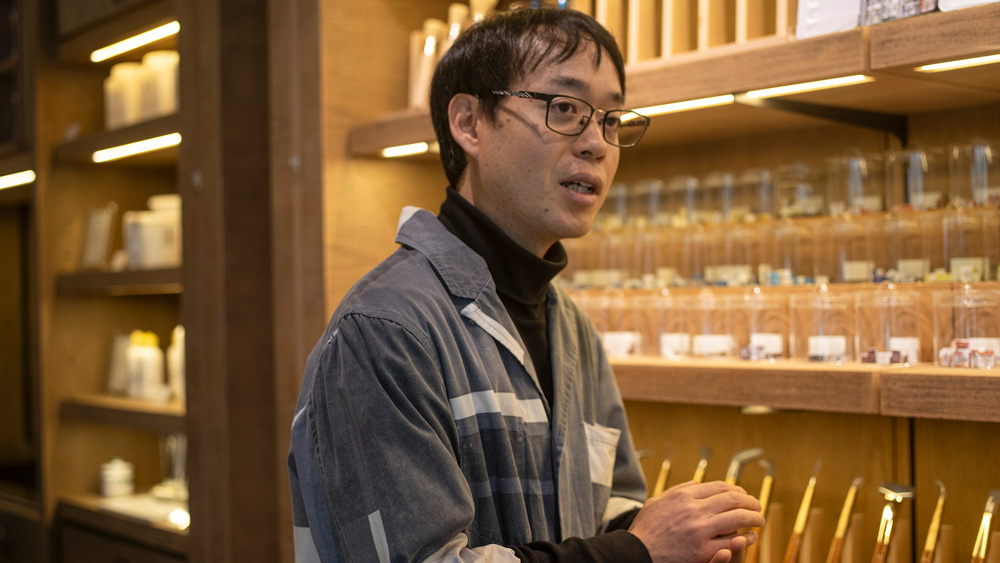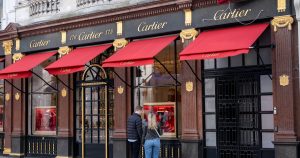Established in 2015 in Tennōzu, Tokyo, and attracting industry professionals and art enthusiasts from both Japan and abroad, PIGMENT TOKYO has emerged as an art supply store specializing in the materials and tools used in traditional Japanese painting, such as mineral pigments, washi paper, and brushes. However, it’s more than just a store. Through the artistic resources, it serves as a platform for experimental and educational initiatives that connect manufacturers and creators, techniques, and knowledge across borders. As it approaches its tenth anniversary in the summer of 2025, we take a fresh look at what PIGMENT TOKYO represents.

Photo Courtesy of PIGMENT TOKYO
Located in Tennōzu, Tokyo, the facility embodies Warehouse TERRADA’s core principle of supporting creativity, which the company considers its top priority among its various art-related businesses. PIGMENT TOKYO was established in 2015 partly to secure and provide rare artistic resources from both Japan and abroad for the company’s conservation and restoration projects. However, it has since evolved far beyond the model of an art supply store and now has many functions: a laboratory where makers and users of art materials share knowledge and develop new products, an educational institution providing workshops and lectures for both art enthusiasts and corporations, and a hub for international exchange through artistic resources. In particular, it has strengthened its presence as a research institution that deepens understanding of art through artistic resources and contributes to the development of culture and arts.

Photo Courtesy of PIGMENT TOKYO
The calligraphy section is a masterpiece, with over 600 kinds of paint brushes, including rare ones.
Upon entering the space designed by Kengo Kuma, where slender bamboo canes delicately create dynamic wave patterns across the ceiling, visitors are first struck by the PIGMENT section (from which the store takes its name, which is pronounced “pigmon,” as in French). The collection includes approximately 4,500 colors, featuring YInMn Blue—the new synthetic pigment, which was discovered by researchers at Oregon State University—as well as extremely rare and high-grade natural pigments such as lapis lazuli, and effect pigments manufactured with the latest technology. The store also stocks various types of nikawa (animal glue), which is essential in Japanese painting to fix pigments to the surface, including PIGMENT TOKYO’s original formula. More than 600 types of paint brushes and rare brushes showcasing Japanese craftsmanship, antique inkstones that could be considered artworks themselves, washi paper, and artistic resources used in traditional Western painting techniques are beautifully displayed (and many can be tested!). Whether you’re a professional, an amateur enthusiast of Japanese or Western painting, or even someone without a particular interest in art, visiting this place will inspire you and arouse your creativity.
What supports PIGMENT TOKYO’s high-level services, from product selection to “soft” aspects such as workshops, is none other than the presence of artists themselves. Here, current emerging artists having various specialties—actual users of the artistic resources—work as staff members, handling everything from customer service to planning and managing workshops.

Photo Courtesy of PIGMENT TOKYO
Artist Masayoshi Nojo majored in Japanese painting at university and, having been part of PIGMENT TOKYO from its inception, has been instrumental in creating its displays. He says that the customer service he provides, backed up by his high level of expertise, is useful for developing his presentation skills as an artist.
As someone involved with PIGMENT TOKYO since the planning stages, Masayoshi Nojo, an artist who majored in Japanese painting at university, has helped create the store’s impressive displays. Through his customer service, which leverages his extensive professional knowledge, he has been able to build up his presentation skills as an artist. Nojo is an emerging talent who has expanded his activities both domestically and internationally with his progressive yet delicate artistic expression that fuses traditional Japanese painting aesthetics and techniques learned at university with various mediums, including photography. He says that his experience here has greatly benefited his artistic activities, particularly in developing his communication skills.
“While creating art is naturally the core of an artist’s activities, communicating about one’s work to various audiences is also an important job—something that isn’t really taught in Japanese art schools. At PIGMENT TOKYO, we get many international visitors, so we’re able to develop communication skills not only in Japanese but also in English. I also feel it’s a place where I can acquire the management skills that will be useful when I establish my own studio one day.”
Being aware of the challenges faced by actual users of PIGMENT TOKYO’s artistic resources often proves valuable. For instance, the shortage of journeymen in Japanese art has long been a serious problem; however, beyond that, other issues are gradually becoming more complex. These include regulations concerning pigments, changing ethical views on the use of animal by-products, and the impact of geopolitics on the sourcing of materials. Nojo, who says he sometimes discusses these issues with overseas customers, continues, “Rather than just worrying about these problems, being able to feed ideas and customer requests back to manufacturers of artistic resources and share challenges as an artist is one of the significant aspects of working at PIGMENT TOKYO. It’s one way we can contribute to the future of the art industry.”
Kei Saito, an artist who has been involved with PIGMENT TOKYO since its second year of operation, agrees with Nojo that “while there are many challenges, PIGMENT TOKYO, as a platform, can contribute significantly to new product development by manufacturers.” He adds, “Manufacturers are making considerable efforts to adapt to the changing times. This might lead to the next innovation in, or price democratization of, artistic resources. I believe PIGMENT TOKYO, by looking to the future, has the potential to promote positive evolution through collaboration between manufacturers and artists.”
Saito acknowledges that, through working at PIGMENT TOKYO, his own art has become more innovative. “In dealing with traditional cultural elements at PIGMENT TOKYO, I started thinking about what could be achieved by combining them with the latest technology. So, going forward, I’m hoping to develop new forms of artistic expression.”

Photo Courtesy of PIGMENT TOKYO
Artist Kei Saito, who majored in oil painting at university, joined PIGMENT TOKYO at the same time that the Western-style painting section was established. In addition to customer service, he is also in charge of planning and managing workshop programs for companies and individuals.
Saito, who majored in oil painting at university and joined PIGMENT TOKYO when the Western painting section was established, handles customer service while also playing a key role in planning and managing workshop programs for corporations and individuals. As a workshop planner, Saito also speaks about how PIGMENT TOKYO deepens mutual cultural understanding.
“We have artists from overseas who come to learn about Japanese painting techniques and materials, and PIGMENT TOKYO artists have traveled to Bhutan to conduct workshops for local conservators on painting techniques using mineral pigments and nikawa. We also frequently receive workshop requests from Japanese companies wanting to build teams and promote artistic thinking. What we can say through these experiences is that by understanding the rationale behind artistic resources, people can deepen their understanding not only of their own culture and how it differs from others but also of other people. We also have to remember that using art materials inherently involves struggles and setbacks. So, given that it includes the experience of overcoming such challenges, I think PIGMENT TOKYO is one of the few places where people can encounter the essence of creativity through art materials.”
Finally, Nojo shared his thoughts on PIGMENT TOKYO’s future:
“PIGMENT TOKYO is like an individual artist. Keen to support it, everyone thinks about how to realize its potential and how it should develop. Now, about ten years since it opened, it’s finally starting to be appreciated by a wide range of people. It’s just like us young artists. I hope that new talents will continue to develop their skills here and let their creativity soar.”
Now, let’s take a look at five particularly noteworthy artistic resources handled at PIGMENT TOKYO:
1. Mineral Pigments (Iwa-Enogu)

From left: Natural gunroku, ¥5,280; natural gunjō, ¥6,050; lapis lazuli, ¥33,000; natural cinnabar, ¥2,530 (all prices are for 15 grams, including tax)
Photo Courtesy of PIGMENT TOKYO

A close-up of the natural ores (natural gunroku and natural gunjō) that are used to make mineral pigments
Photo Courtesy of PIGMENT TOKYO
PIGMENT TOKYO stocks approximately 4,500 colors of pigment. Mineral pigments are made from crushed natural minerals and have a history of nearly 1,500 years, having been introduced to Japan from China during the Kofun period. Among these, a symbolic color is gunjō, made from azurite. Historically, there are records of it being produced in Akita Prefecture, which had copper mines, but like lapis lazuli, it was extremely rare because of the demanding refining processes involved. Gunjō was used in the iris flowers of the Kakitsubata-zu national treasure by Ogata Kōrin of the Rinpa school. Mineral pigments include both traditional natural materials and shin-iwa-enogu (new mineral pigments) made from synthetic stones created chemically by adding metal oxides to glass. A major characteristic of mineral pigments is that their shade varies with particle size. Larger particles produce deeper colors, while smaller ones create lighter shades. Particle size is indicated by number, and PIGMENT TOKYO handles each color from the largest size 5 to the smallest size 13, and byaku (white).
2. TranTixxii® Color Titanium Panels

F6 size (41 × 31.8 cm) from ¥9,900 (photo shows sample)
Photo Courtesy of PIGMENT TOKYO
TranTixxii® is an innovative base material developed jointly over five years by Nippon Steel Corporation and PIGMENT TOKYO. Made of lightweight and robust titanium, it creates rich color variations through proprietary technology controlling its patina. Suitable for oil and acrylic paints, it serves as a durable support while expanding artistic possibilities by exploiting this colorful material’s hues. The material, which transcends artistic boundaries, is used for tiles and roofing materials. It has been used in the main hall of Tokyo’s Sensoji Temple, Kitano Tenmangu’s treasure house, and Frank O. Gehry’s Hotel Marqués de Riscal in Elciego, Spain. Such dynamic developments are unique to collaborations with manufacturers from other fields.
3. Nikawa (Animal Glue)

From left: Pig Skin Glue, ¥1,320 (100 g); Clear (Fish) Glue, ¥770 (10 g); cow glue, ¥880 (100 g)
Photo Courtesy of PIGMENT TOKYO

PIGMENT TOKYO also sells its own original glue.
Photo Courtesy of PIGMENT TOKYO
Nikawa is an essential material in Japanese painting, being used for mixing mineral pigments and sizing support materials such as washi paper and silk (dōsa-biki). Made from animal skins and bones, it comes in various forms including sticks, sheets, and granules. When used, it’s mixed with water and heated in a water bath to create nikawa liquid. PIGMENT TOKYO manufactures original nikawa liquid by selecting the most suitable glue available at the time. Nikawa sources include cows, fish, pigs, deer, and rabbits, each glue having its own characteristics—pig and fish glue are ideal for dōsa-biki (sizing) while ox glue is best for painting—allowing users to choose according to purpose and preference. With very few manufacturers remaining in Japan, ensuring a stable supply of nikawa is currently a challenge, but PIGMENT TOKYO supplements supply through traditional manufacturers and custom orders through unique supply routes established over time.
4. Brushes

From left: “Meisei” Namura Taiseido, ¥9,900; Nakasato Sakuyō extra-large brush, ¥5,610; Bamboo handle squirrel hair paintbrush, ¥18,700; Nakasato Hakuzen brush size 40, ¥7,590; Nakasato renpitsu special 10-piece set, ¥18,700; Kobayashi Tsukemawashi-bake special (thin paste brush), ¥14,300
Photo Courtesy of PIGMENT TOKYO
A major characteristic of Japanese painting is the outlining of compositional elements. Even for simply painting lines, there are variations such as the sokumyō brush with its long, soft tip for gently expressive strokes; the sakuyō brush, whose firmness is ideal for applying both strong and weak strokes; and the mensō brush, whose overall thinness is suitable for detailed line work. Also, tools such as the karabake brush are essential for the mōrō-tai (blur style) technique developed by Yokoyama Taikan and Hishida Shunsō under Okakura Tenshin’s guidance in the Meiji era. Thus, the variety of brushes in Japanese painting is surprisingly broad compared to that in Western painting. PIGMENT TOKYO handles about 600 types of brush, 90% of which use natural bristles. Recently, however, with soaring prices and the difficulty of obtaining natural hair, manufacturers of artistic resources, guided by feedback from PIGMENT TOKYO’s artists, are developing brushes with synthetic bristles such as nylon.
5. Inkstone (Suzuri)

Clockwise from top: She inkstone, Suikō with kinsei kinka pattern, antique Rōkō Suigankutsu inkstone with Bashō carving, Duan inkstone, Mashiko, flower vase shape (prices upon request)
Photo Courtesy of PIGMENT TOKYO
Japanese painting features various modes of expression using black ink, from line drawing to tarashikomi, where concentrated ink is dropped into diluted ink. Ink originated in ancient China and came to Japan around the second century. Inkstones for grinding solid ink are also important items. There are Chinese tōken and Japanese waken inkstones, and while PIGMENT TOKYO stocks various types for practical use, some have antique art value. The rōkō grade of Duan inkstones, made of fine stone quarried from the valley in Zhaoqing, Guangdong Province, China, is said to be the finest, maximizing the ink’s luster and color quality. It features beautiful decorative carvings. These precious items reportedly escaped destruction by being exported to Japan during China’s Cultural Revolution.





